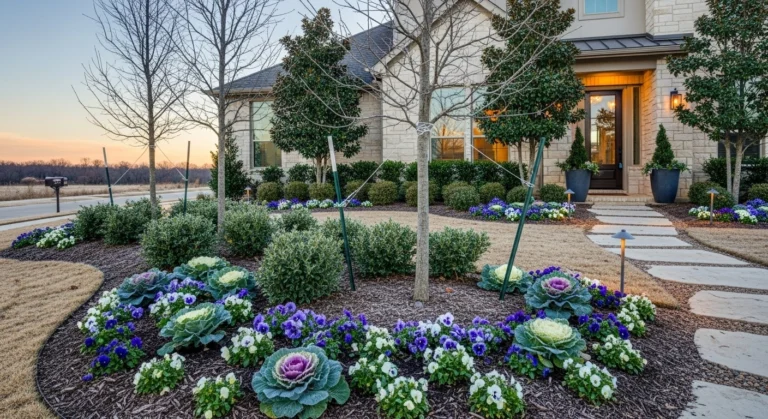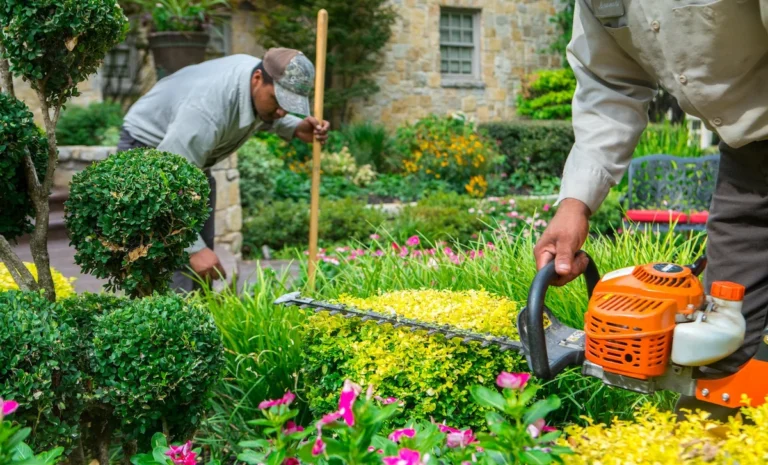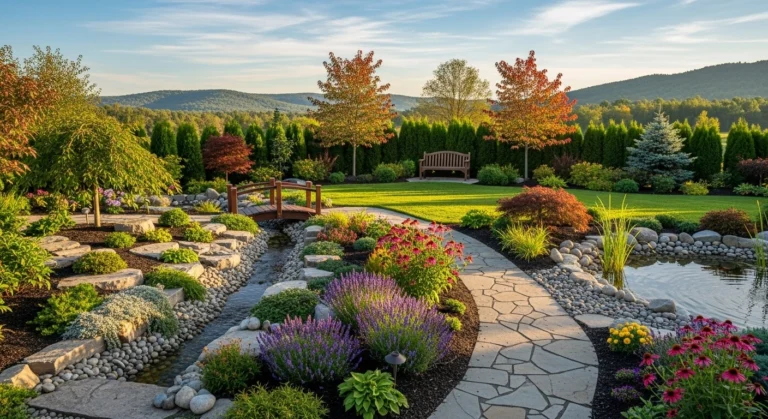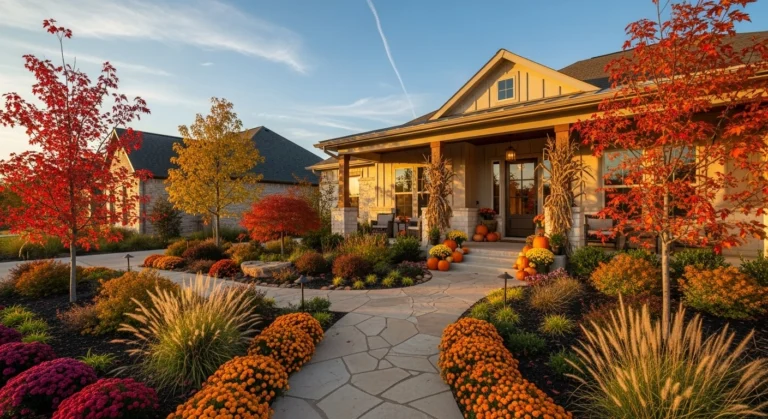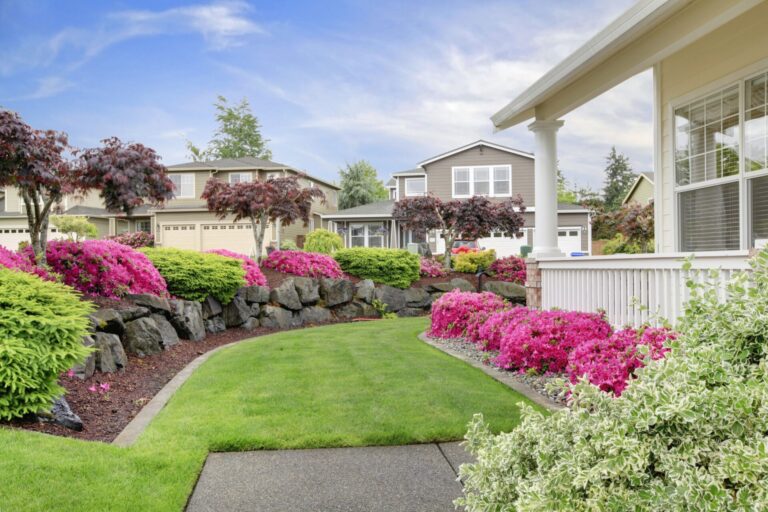The Art of Blending Stone and Nature in Your Landscape
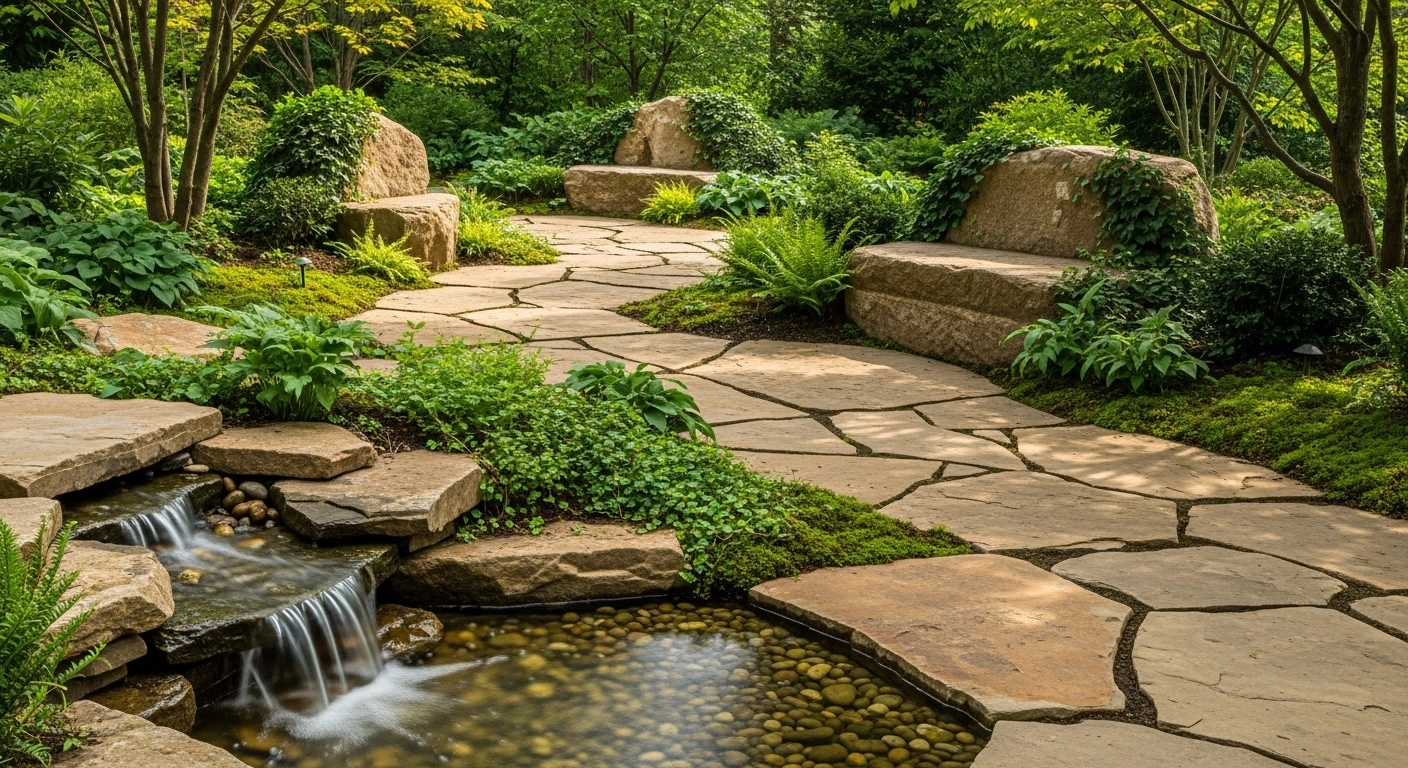
Every weekend, you walk through your yard with a mixture of excitement and frustration, dreaming of the perfect outdoor space but feeling torn between practical needs and natural beauty. You love the idea of a stone patio for entertaining, but worry it will make your yard feel cold and sterile; you want lush gardens, but need low-maintenance solutions that can handle Central Texas heat and your busy schedule. We’ve worked with hundreds of Waco homeowners who feel caught between these competing visions, unsure whether to invest in permanent structures or focus on plantings that might not survive our challenging climate. The result is often a landscape caught in limbo – neither fully functional nor truly beautiful, leaving families with outdoor spaces that never quite live up to their potential.
The breakthrough comes when you realize that landscape harmony isn’t about choosing between stone and plants, but about orchestrating them into a symphony that serves your lifestyle while celebrating the natural beauty of Central Texas. At Lawn Care Waco, we’ve perfected the art of creating outdoor spaces where every hardscape element makes nearby plants look more stunning, and every planting softens and enhances architectural features. The magic happens when stone patios provide the perfect stage for dramatic plantings, when trees offer essential shade that makes outdoor structures usable year-round, and when the interplay between permanent and living elements creates spaces that evolve beautifully through seasons and years. This integrated approach doesn’t just solve the either-or dilemma – it creates outdoor experiences that are greater than the sum of their parts.
The Hidden Psychology of Outdoor Space Design
Most people don’t realize how profoundly the balance between built and natural elements affects how they feel in their outdoor spaces, but the psychological impact is immediate and lasting. Emotional comfort comes from environments that feel neither completely wild nor overly controlled, striking a balance that speaks to our deep need for both security and connection to nature. We’ve watched families transform their relationships with their yards when we get this balance right, suddenly finding themselves drawn outside for morning coffee, evening conversations, and weekend relaxation in ways they never experienced before.
The practical implications go far beyond feelings, affecting how much you actually use and enjoy your outdoor investment. Functional comfort requires the right combination of stable surfaces for furniture and activities, natural elements that provide climate control and visual interest, and transitions that make movement through outdoor spaces feel logical and inviting. When landscapes lean too heavily toward hardscape, they become hot, glaring environments that families avoid during much of the year; when they rely entirely on softscape, they often lack the structure and usability that makes outdoor living practical.
What makes Central Texas particularly challenging is our intense summer heat, unpredictable storms, and soil conditions that can be unforgiving to both structures and plants. Climate resilience comes from understanding how hardscape elements can protect and support plantings, while strategic vegetation can moderate the harsh conditions that make stone and concrete surfaces uncomfortable or even dangerous. Smart design integration creates microclimates where each element moderates the extremes that challenge the others.
Building Your Landscape’s Structural Foundation
Essential Hard Elements That Define Outdoor Spaces
Entertainment areas form the social heart of most outdoor spaces, providing reliable surfaces where families can gather regardless of weather conditions or soil moisture. We design these spaces as natural extensions of indoor living areas, considering factors like traffic flow from the house, views toward interesting landscape features, and protection from prevailing winds. The key is creating outdoor rooms that feel connected to your home’s architecture while being sized and positioned for how your family actually uses outdoor space.
Circulation systems including walkways, steps, and defined pathways do much more than provide access – they organize your landscape experience and protect planted areas from trampling damage. Structural support elements like retaining walls and raised planters solve slope and drainage challenges while creating opportunities for dramatic plant displays and additional seating areas. These permanent features become the skeleton that supports and showcases the living elements of your landscape.
Utility integration through features like outdoor kitchens, fire features, and irrigation systems transforms outdoor spaces from seasonal decoration to year-round living areas. Water management structures including drainage strategies that handle stormwater while creating interesting landscape features represent hardscaping at its most functional and beautiful. The best permanent elements multitask, solving practical problems while contributing to your landscape’s aesthetic appeal.
Material Selection for Central Texas Durability
Local stone options perform exceptionally well in our climate while providing authentic regional character that connects your landscape to Central Texas’s natural heritage. Native limestone, sandstone, and river rock offer thermal properties that moderate temperature extremes while developing attractive patinas that improve with age. These materials require minimal maintenance while providing surfaces that remain comfortable even during hot summer months.
Engineered materials including high-quality concrete products and composite options offer design flexibility and consistent performance when chosen carefully. Permeable alternatives address stormwater management requirements while providing the clean lines and durability that many contemporary designs require. We focus on products that maintain natural appearance while offering superior performance in extreme weather conditions.
Metal and wood accents can add warmth and visual interest to stone-dominated designs when selected for weather resistance and longevity. Integrated lighting and other functional elements should be planned during initial construction to avoid disrupting completed hardscape features. Quality material selection affects both immediate appearance and long-term performance, making informed choices crucial for landscape investment success.
Nurturing the Living Elements of Your Design
Plant Strategies That Enhance Built Features
Architectural plantings around hardscape elements must be tough enough to handle reflected heat and potentially challenging growing conditions while providing the softening effect that makes outdoor spaces feel welcoming. We select species that offer multiple seasons of interest without growing large enough to overwhelm or damage permanent structures. Strategic plant placement can transform stark hardscape installations into integrated outdoor environments that feel natural and inviting.
Canopy trees function as living umbrellas that make stone patios and concrete surfaces comfortable during brutal summer months while providing vertical structure that balances horizontal hardscape lines. Understory selections create layered plantings that provide visual depth and seasonal interest while thriving in the unique microclimates created by nearby structures. Our Central Texas plant selection expertise ensures that living elements complement rather than compete with permanent features.
Seasonal accent plantings through containers and flexible garden areas allow for creative expression and seasonal change without compromising the stability that permanent plantings provide. Native plant integration creates sustainable landscapes that thrive with minimal inputs while supporting local wildlife and reinforcing connection to Central Texas’s natural character. The goal is creating plant communities that enhance hardscape investments while requiring reasonable maintenance and providing year-round beauty.
Designing Living Spaces That Flow Naturally
Edge transitions between hardscape and planted areas require careful planning to create seamless visual flow while preventing maintenance conflicts between different landscape elements. Layered plantings create depth and visual interest while establishing clear boundaries that protect both structures and sensitive plants from potential damage. These transition zones often become the most interesting and memorable parts of outdoor spaces.
Microclimate optimization around permanent structures takes advantage of protection, thermal mass, and modified sun patterns to create growing conditions that support a wider range of plants than open landscape areas. Seasonal interest coordination ensures that plantings provide compelling beauty throughout the year, with structural plants maintaining visual weight during winter months while seasonal displays create dramatic spring and summer focal points.
Wildlife habitat integration through thoughtful plant selection creates outdoor spaces that feel alive and connected to the broader ecosystem while providing entertainment value through bird and butterfly activity. Fragrance and texture considerations add sensory richness that makes outdoor spaces more engaging and memorable, encouraging families to spend more time enjoying their landscape investment.
Mastering the Integration Art
Proportion and Scale Fundamentals
Visual balance typically works best when landscapes maintain roughly 60-70% living elements to 30-40% built structures, though this ratio can shift based on lifestyle priorities and maintenance preferences. Properties focused on extensive outdoor entertaining might use more hardscape, while wildlife-friendly landscapes might emphasize plantings with strategic structural accents. The key is ensuring that neither element dominates to the point of making the other feel insignificant or out of place.
Mature size planning prevents future conflicts by considering how growing plants will relate to permanent structures over time. Spatial relationships between different elements must account for how people actually move through and use outdoor spaces, creating logical flow patterns that feel natural and inviting. Our landscaping guide helps clients visualize how integrated designs will evolve and function over time.
Focal point distribution across the landscape prevents designs from feeling unbalanced or visually chaotic while ensuring that different areas offer distinct experiences and functions. Color coordination between hardscape materials and plant selections creates cohesion while allowing for seasonal variation and creative expression within a unified design framework.
Seasonal Functionality and Year-Round Appeal
Four-season planning ensures that integrated landscapes provide beauty and functionality throughout the year, with permanent elements providing structure during dormant seasons while plantings create dynamic seasonal changes. Weather adaptation considers how different combinations of materials and plants respond to Central Texas’s climate extremes, creating outdoor spaces that remain comfortable and attractive regardless of seasonal conditions.
Maintenance accessibility must be designed into integrated landscapes from the beginning, ensuring that both permanent structures and living elements can be properly cared for without conflicting with each other. Equipment access and storage considerations prevent beautiful designs from becoming maintenance nightmares while preserving the aesthetic integration that makes landscapes successful.
Flexible use areas accommodate different activities and seasons by incorporating elements that can adapt to changing needs while maintaining design integrity. Lighting integration extends the usability of outdoor spaces while highlighting both architectural and natural features after dark, creating completely different landscape experiences that showcase integration success.
Avoiding Integration Pitfalls
Structural Problems That Harm Plants
Heat island effects from extensive paved areas can create conditions that stress even drought-tolerant plants, particularly when hardscape materials are positioned without considering sun angles and reflection patterns. We’ve seen excellent plant selections fail because designers didn’t account for how stone walls and concrete surfaces would amplify already challenging summer conditions. Thermal mitigation through strategic shading and material selection prevents these problems while maintaining hardscape functionality.
Water flow disruption from poorly planned hardscape installations can create drainage problems that affect both structures and adjacent plantings. Irrigation conflicts occur when hardscape elements interfere with efficient water delivery to planted areas, leading to both plant stress and water waste. Successful integration requires coordinating water management from the earliest planning stages to ensure all landscape elements receive appropriate moisture while preventing damage from excess water.
Construction damage to existing plants and soil during hardscape installation can create long-lasting problems that affect landscape performance for years. Root zone protection during construction and proper soil restoration afterward are essential for maintaining healthy growing conditions around new permanent features. Professional landscaping services include plant protection protocols that preserve existing landscape investments during construction phases.
Plant Choices That Threaten Structures
Invasive root systems can cause expensive damage to hardscape elements when aggressive species are planted too close to structures or when root barriers aren’t properly installed. Maintenance conflicts develop when plants require care that conflicts with hardscape functionality, such as messy species over entertaining areas or thorny selections along walkways. Strategic plant selection prevents these conflicts while maintaining landscape beauty and functionality.
Growth habit problems occur when plants outgrow their allocated space and begin crowding or damaging permanent structures. Debris issues from plants that drop leaves, flowers, or fruit onto hardscape surfaces create ongoing maintenance problems and potential safety hazards. Irrigation overspray onto hardscape can cause staining and slip hazards while wasting water and potentially promoting algae growth on stone surfaces.
Chemical incompatibilities between plant care products and hardscape materials can cause permanent staining or surface damage. Seasonal safety concerns including ice formation from irrigation near walkways or slip hazards from fallen leaves on smooth surfaces require planning during plant selection and placement phases.
Investment Planning for Integrated Landscapes
Hardscape Budget Considerations
Upfront investment in quality hardscape elements typically exceeds plant installation costs but provides decades of functionality with minimal maintenance when properly installed. Material longevity varies significantly between options, with higher-grade choices often providing better value through extended lifespan and reduced replacement needs. We help clients understand total cost of ownership rather than just initial installation expenses.
Professional installation value becomes particularly important for permanent structures because mistakes are difficult and expensive to correct. Code compliance and permit requirements often apply to hardscape construction, particularly for structures that affect drainage or utilities. Our experience with local regulations prevents costly delays and ensures long-term compliance with applicable requirements.
Phased implementation strategies can help manage budgets while ensuring that early installations support rather than conflict with future additions. Future expansion planning prevents expensive modifications by considering how current installations might need to accommodate future landscape development or changing family needs.
Maximizing Plant Investment Returns
Establishment support costs include soil preparation, irrigation installation, and care during critical first growing seasons when plants are most vulnerable. Species selection impact on long-term maintenance costs can be dramatic, with appropriate choices requiring minimal inputs while poor selections demand constant attention and frequent replacement. Our landscape maintenance expertise helps clients understand the long-term financial implications of different plant strategies.
Container vs. ground planting economics vary based on plant types, design goals, and maintenance preferences. Seasonal replacement budgeting should account for annual displays and container plantings that provide flexibility but require ongoing investment. Perennial investments in quality trees and established shrub selections provide long-term value while reducing ongoing costs compared to landscapes requiring frequent plant replacement.
Water-wise strategies can significantly reduce ongoing irrigation costs while supporting environmental sustainability. Native plant advantages include reduced water, fertilizer, and pest control requirements along with better climate adaptation and wildlife value. Smart plant investment focuses on species that thrive rather than merely survive in Central Texas conditions.

